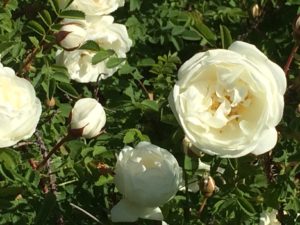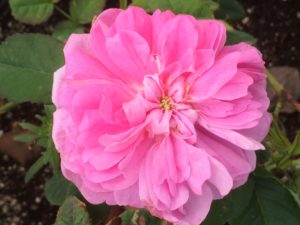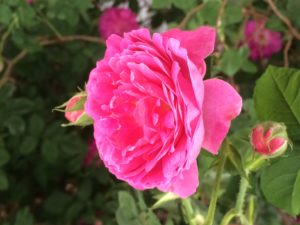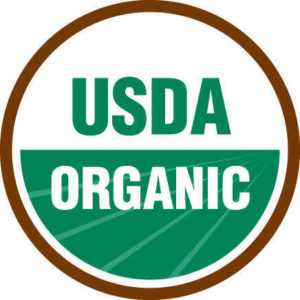SPRING THINGS TO DO IN YOUR ORGANIC GARDEN

DOUBLE WHITE BURNET ROSE

LAURA ROSE

GREAT WESTERN ROSE

ORGANIC GARDENING NOTES FOR EARLY SPRING
The ground is thawed in the valley and soon the foothills will be snow free. As soon as the earth dries out and wet turns to moist, you can work up the soil. Dry organic amendments can then be forked into your beds. Organic blood meal (13-0-0) is an excellent source of nitrogen and is quickly taken up by plants. Alfalfa meal (3-1-3) will enrich soil with a moderate amount of nitrogen, small amount of phosphorous, and a moderate amount of potash. Ground fish bone meal (5-16-0) also contains moderate amounts of nitrogen, but is a terrific source of phosphorous.
Well-rotted manure (usually about 3-1-1) will add a good amount of nitrogen and smaller amounts of phosphorous and potash, but adds lots of beneficial, moisture-holding organic matter. Be careful in sourcing manure as it may contain high levels of salt (especially if sourced from feed lots). It is safest to use one year old, well-rotted manure on food crops. Too fresh of manure will burn crops and can contain pathogens. In our USDA Certified Organic market garden we are only allowed to use manure from grazed land that is at least one year old; and it must be applied at least 120 days before crops are planted. Another option is to use manure that has gone through a heat of at least 160 degrees F. for 3 weeks; this kills harmful pathogens. Compost may be spread on a USDA Certified Organic farm or garden but it must be made only from vegetable matter—no meats, dairy products or eggs, etc.
If you are starting a new garden bed, spread cardboard, rotted moist straw, or tarps to kill grass out. Newspapers will dry up and blow away unless anchored by rocks or chunks of turf. You can till right into the turf to prepare your spot, but weeds will be present and you will have to keep after them. Try to till only once, pull weeds out, add amendments and mulch the soil until ready to plant. Too frequent tilling destroys the structure of the soil and causes it to release carbon.
Remember that healthy organic soils are alive with microbes and fungi that help plants pull CO2 out of the atmosphere. By gardening organically you are helping the earth to gather and store carbon dioxide. This is exactly the opposite environmental effect of conventional gardening, which uses chemical fertilizers and often features bare soil. Chemical fertilizers require large amounts of carbon to make and bare soil causes soil organisms to die; with the result that soils lose carbon rather than pulling carbon out of the atmosphere and storing it.
Forest, grassland and hedgerow soils pull the most carbon from the atmosphere of any land ecosystems. In your garden, you can help this process by setting aside areas for wildflowers and grasses, shrubs, shrub borders and shelter belts or groups of trees with wildflowers and/or groundcovers underneath. You will be providing habitat for endangered native bees, butterflies, birds and reptiles as well as building carbon storage.
Now is the time to start your peppers, onions, leeks, tomatoes, tomatillos, and eggplants from seed to set out in May. Wait until late April/early May to start squash, pumpkins, watermelons, canteloupes, etc. If you plan to set out cauliflower, cabbage, kale, broccoli or other cole crops in mid-to late April, start them from seed inside now also. A soil free organic seedling mix can be made from: 3 parts peat, 2 parts vermiculite, and 1 part perlite. Heat mats placed under flats will aid germination of crops that like warm temperatures, such as peppers and tomatoes. An east facing window is satisfactory, or fluorescent lights hung a few (8 to 10 inches) inches above the flats.
Soon containerized fruit trees, shrubs, roses, bulbs, perennials, plus annual flowers and vegetables will be available in your local organic garden shops. This year, I have grown several varieties of Certified Organic shrub roses on their own roots, found on old homesteads here in the Mission Valley:
‘Great Western’, a Hybrid Bourbon shrub rose is a long-time favorite in our area. This rose was introduced in 1838, named after one of the first transatlantic steam ships. It blooms for about three weeks in late spring/early summer. The plant is tall and wide, about 6 feet tall and 5 feet wide. The flowers are fully double; a blend of rich reds and purples, with wonderful fragrance. My grandmother grew this rose and there are plants at the museum in Ronan. ‘Great Western’ is a hardy, easy to grow shrub rose. The plant spreads slowly.
‘Laura’, a Centifolia rose from 1837, was found in Ronan, at an old home built in 1913. It is a rather short plant, with fully double, fragrant, powder pink blooms. It is also a once bloomer, with a flowering period lasting about 3 weeks in late spring/early summer. The plant spreads once established, but this is an advantage if your garden has an abundance of voles. When a young plant is put in, a vole cage could be placed around the roots, but the plant will eventually spread outward and in later years a plant with an abundance of root stems will survive vole trails.
‘Double White Scotch Rose’ introduced in 1808, is another locally found variety. It has pure white, double, fragrant flowers in late spring. It is of the same rose family as ‘Harison’s yellow’ the popular, thorny, hardy yellow shrub rose. ‘Double white is equally hardy and trouble free, and spreads on its own roots to form a beautiful large group of plants. I have seen established plants about 7 feet tall and spreading to about 8 or 10 feet wide.
